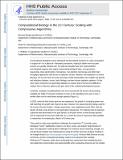Computational biology in the 21st century
Author(s)
Berger Leighton, Bonnie; Daniels, Noah; Yu, Yun William
Downloadnihms894489.pdf (1.359Mb)
OPEN_ACCESS_POLICY
Open Access Policy
Creative Commons Attribution-Noncommercial-Share Alike
Terms of use
Metadata
Show full item recordAbstract
Computational biologists answer biological and biomedical questions by using computation in support of—or in place of—laboratory procedures, hoping to obtain more accurate answers at a greatly reduced cost. The past two decades have seen unprecedented technological progress with regard to generating biological data; next-generation sequencing, mass spectrometry, microarrays, cryo-electron microscopy, and other highthroughput approaches have led to an explosion of data. However, this explosion is a mixed blessing. On the one hand, the scale and scope of data should allow new insights into genetic and infectious diseases, cancer, basic biology, and even human migration patterns. On the other hand, researchers are generating datasets so massive that it has become difficult to analyze them to discover patterns that give clues to the underlying biological processes.
Date issued
2016-08Department
Massachusetts Institute of Technology. Computer Science and Artificial Intelligence Laboratory; Massachusetts Institute of Technology. Department of Electrical Engineering and Computer Science; Massachusetts Institute of Technology. Department of MathematicsJournal
Communications of the ACM
Publisher
Association for Computing Machinery (ACM)
Citation
Berger, Bonnie, Noah M. Daniels, and Y. William Yu. “Computational Biology in the 21st Century.” Communications of the ACM 59, no. 8 (July 22, 2016): 72–80, New York, NY, USA, Association for Computing Machinery (ACM), August 2016.
Version: Author's final manuscript
ISSN
0001-0782
1557-7317